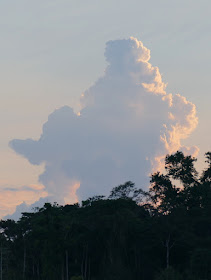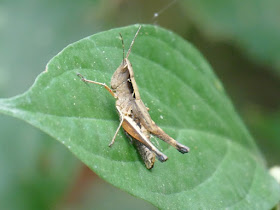In southern Peru there are a couple of major options for an Amazon adventure, and who would go to Peru without immersing themselves in the vast lowland rainforest? Well, probably no-one who is reading this at least! Manu is perhaps the better-known of these, but another option is Tambopata, also accessed from the somewhat Wild West river town of Puerto Maldonado. (Most Manu expeditions either start or end here.) I've had the pleasure of both reserves, and am not touting one above the other, but I always like to shine a light on possibly less well-known destinations.
 |
| Evening cloud over the rainforest in Tambopata National Reserve. |
The reserve lodge, Tambopata Research Centre, is run by Rainforest Expeditions, a private company which supports macaw research (in particular) and local community development by ecotourism. The hundred kilometre river trip - the lodge takes pride in its claim to being one of the most remote in South America - takes a good seven hours, and to fit in with flights and avoid being on the river at night, the journey is broken with a stay at their sister lodge, Refugio Amazonas. (This is a nice lodge too, and you could stay just here if short of time, but that would be a pity.)
 |
| Puerto Maldonado, a town of 25,0000, marked by the end of the red arrow, is on the confluence of the Tambopata and Madre de Dios Rivers. |
 |
| The location of the Tambopata Research Centre. |
This magnificent Amazon basin reserve protects 1.4 million hectares of lowland primary rainforest and savannah in south-eastern Peru. It comprises the vast Bahuaja-Sonene National Park (1.1 million hectares where few visitors are allowed and there are no roads), with the 300,000 hectare Tambopata National Reserve acting as a buffer to the park. The reserve was declared in 1990 after a 13 year process of research and lobbying by scientists and community. The national park was declared in 1996. Within the reserved area are nearly 700 species of birds, over 100 mammal species (including Jaguar and Giant Otter), 120 species of frogs, 70 of reptiles and 1300 species of butterflies! It is regarded as one of the most biodiverse regions on earth. (While some of these figures are lower than those for nearby Manu National Park, which is to the west of Puerto Maldonado, that park extends from the Amazon basin up to 4000 metres above sea level in the Andes; Tambopata is all lowland.)
 |
| White-lipped Peccaries Tayassu pecari - this photo of part of the herd was taken from the lodge verandah! |
However that photo can be a taster for next time, as today I want to set the scene to some extent, and look a small selection of the vast diversity of invertebrate life that abounds, plus a couple of reptiles and frogs - we need to give them top billing sometimes! The mammals and birds can wait until next posting.
I somehow managed to omit taking photos of the accommodation (probably too busy with the wildlife), but you can get some idea here and here. Rooms are very comfortable and open onto the forest - we watched a mother and baby titi monkey from our 'window' - but are not en suite. That has been a feature of Peruvian Amazon lodges, but it might be changing with newer ones.
The rainforest, naturally, is all around.
 |
| Early morning in the forest. |
Palms are a feature of Amazonia.
 | ||
|
 |
| Richeria obovata (I believe) family Phllyanthaceae. This is what I noted at the time, though I can't recall my source. I'm not so convinced now, so any assistance would be gratefully received. |
A feature of Tambopata is the proximity of what is claimed to be South America's largest clay lick near to the lodge. To avoid disturbance visitors are kept 150 metres from the closest part of the lick, which makes observation more difficult than some others in the region (eg Blanquillo on the Madre de Dios, west of Puerto Maldonado). This is not a complaint by the way, I fully support any measures that are for the benefit of wildlife. We didn't have a lot of luck either; the first morning the birds only came sporadically - it happens - and heavy overnight rain meant that they didn't come at all the second day.
 |
| Collpa Colorado, which is 500 metres long and up to 30 metres high. |
Here are some reptiles (some in need of better identification; any assistance gratefully accepted).
 |
| I think this one is a teid (ie family Teidae) but that's as far as I can go at present. |
 |
| Green Anole; anoles are in the iguana family. |
 |
| Yellow-spotted River Turtles Podocnemis unifilis. (The yellow spots are on their faces.) |
 |
| Engystomops freibergi, family Leptodactylidae, which has a couple of hundred species throughout South America and as far north as Mexico. I love the camouflage of this little frog. |
And so to the invertebrates, too few of which, almost needless to say, I am able to identify - if you can, please help, otherwise we can just enjoy them together.
As mentioned previously, Tambopata, like all the Amazon basin, is rich in butterflies.
 |
| These two, and the next, with only four visible legs (the other pair is tucked up out of the way) are in the huge Nymphalidae family (thanks Susan!). |
This unfortunate butterfly however was definitely on the menu, albeit not ours.
 |
| It was being attacked by army ants, outliers of the main column (below). |
 |
| The term army ant refers to any of some 200 species which do not dwell in nests, but move in vast columns through the forest, scouring it for food and 'camping' (or bivouacking) overnight. |
The rest of the animals in these photos were well away from the ants, and presumably happier than the last couple!
 |
| I was told that this is a dung beetle - it could well be, though I have no way of verifying that. However I'm pretty sure that it is at least a scarab. |
 |
| Cicada; I'm not sure about the odd blue tinge - I certainly haven't been fiddling with the colours! |
 |
| Grasshopper. |
 |
| Katydid (at night in the forest). |
 |
| Rainbow Katydid (Vestria sp.?); this is a genus of predators. |
 |
| Praying mantis. |
 |
| A beautiful spiny spider. |
 |
| One of the ground-hunting tarantulas. Always, for me, a highlight of a visit to the Amazon; this was taken on a night walk. |
NEXT POSTING THURSDAY.
(And
remember that you can get a reminder when the next post appears by
putting your email address in the Follow by Email box in the top right
of this screen.
And I'd love to receive your comments - it's easy and you don't need to sign in!)
And I'd love to receive your comments - it's easy and you don't need to sign in!)





The first two photos of butterflies are Nyphalidae (only 4 visible legs). I can't go further than that. The first 'grasshopper' is a female bush-cricket (aka katydid) -- very long fine antennae, sabre like ovipositor.
ReplyDeleteThanks for those tips Susan - duly acknowledged and incorporated above. And I'll try and remember it all too!
ReplyDelete